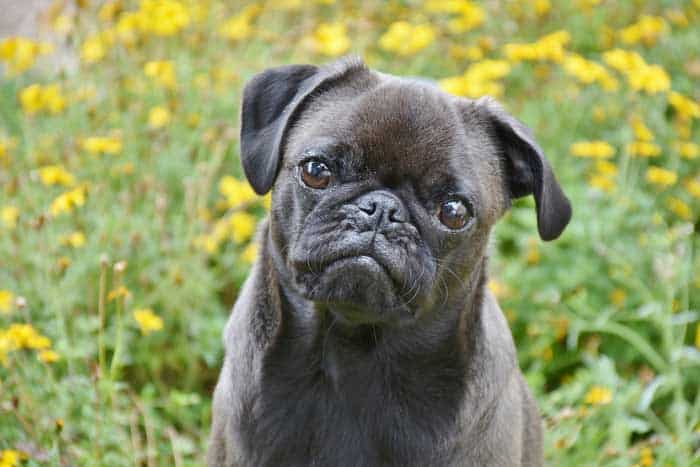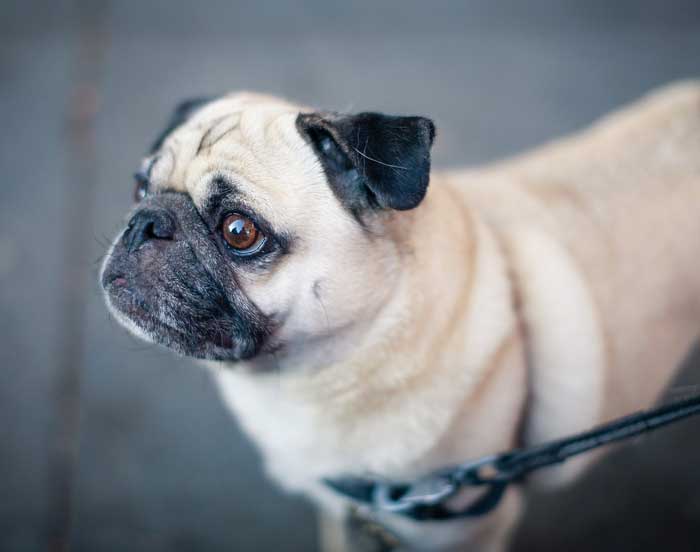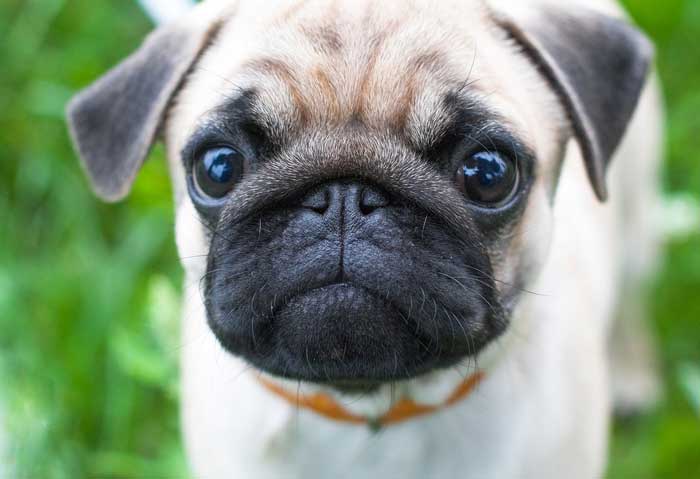Pugs are one of the largest toy dog breeds, but, although small, Pugs have a great personality.
They are somewhat lazy dogs who like to sleep, but when awake they are playful and lively.
Pugs are good family dogs and great companions but, are Pugs good apartment dogs?
Pugs are great dogs for apartment living. It’s a toy breed that adapts well to living in small spaces and doesn’t require a lot of exercise. They are dogs with a friendly and social personality in addition to being a relatively quiet breed. Pugs can be one of the best companions for apartment life.
But it is necessary to know more about Pugs to be sure, not only if they adapt well to apartment life, but also our lifestyle.
We must be sure that we can provide them with a happy and healthy life when living in an apartment.
What You Should Know About Living with a Pug

Pugs are great companion dogs with an outgoing and affectionate personality.
They are very playful but they also love to cuddle and sleep. Pugs tend to sleep longer than other dog breeds. On average, a Pug can sleep about 14 hours a day.
It’s common for Pugs to be referred to as “shadows” because they always want to be with their owners and follow them everywhere.
Are Pugs Good Family Dogs?
Pugs are known to be excellent family dogs. They are very playful dogs who love to spend time with their family.
They are a good option for families with children. They are very playful and are generally patient with children and due to the shape of their mouth, they cannot give an aggressive bite which makes them safe dogs for children.
But, despite being robust enough, they are very fragile dogs so you have to take care of them when they interact with children so that they do not accidentally hurt them.
Pugs often get along well with other pets, even cats.
Do Pugs Need to Be Groomed?
Pugs are relatively low maintenance, although they do need regular basic care.
Their short coats need minimal maintenance, but they are considered heavy shedders. Pugs shed throughout the year and not seasonally like most dogs.
Providing a weekly brushing is enough to help remove excess hair.
As with all breeds with a wrinkled face, they are prone to getting infections on their facial skin folds. This is why it’s necessary to keep the Pug’s wrinkles dry and clean.
In addition to this, a Pug only needs minimal basic care.
A Pug does not need to bathe often, only when it gets dirty by something specific or to keep its “dog odor” under control.
In case they don’t wear them down naturally when walking, their nails must be cut regularly so they don’t hurt you.
Do Pugs Need a Lot of Exercise?
Pugs are one of the least active dog breeds out there. They are happy sleeping and cuddling together with their owner.
It’s also a brachycephalic breed that tends to have trouble breathing and controlling the internal temperature of his body. This is why they shouldn’t have strenuous exercise and we must take care of their physical activity during hot and humid climates.
However, a daily exercise routine is essential for Pugs and they will also enjoy the physical activity and mental stimulation.
Among the benefits of giving a Pug regular exercise are:
- It helps maintain his muscle tone which helps protect his hips and knees.
- It helps control his weight since they tend to be overweight.
- Reduces the risk of heart disease.
- It allows a Pug to release his energy and helps prevent behavior problems.
Due to his breathing problems, the ideal physical activities for a Pug are short walks and some indoor or outdoor playtime.
Pugs should have between 40 minutes to an hour of daily exercise. Two 20-minute sessions are preferable so they don’t get physically exhausted.
Are Pugs Easy to Train?
Pugs are intelligent dogs but are reputed to be difficult to train. They are stubborn, somewhat rebellious, and are easily distracted.
To train a Pug successfully you have to be patient, consistent, and start training them at an early age.
It’s very common for owners to be permissive with toy breeds as they are thought to be easier to control and do less damage than a larger dog. But a toy breed, as is the case with the Pug, can be a real trouble maker.
It’s important to start teaching them good behavior and basic obedience commands from the moment they get home to prevent them from developing bad habits and prevent behavior problems.
You have to establish the house rules from the beginning. Some of the most common are:
- No biting
- No chewing
- No playing with food
Training an adult Pug is more difficult, but not impossible. Although it’s never too late to start training a dog, if you start training a Pug from the moment he arrives home, training will be easier and more fun for both of you.
Are Pugs Easy to Potty Train?
Housetraining a Pug can be a challenge. But with time and patience, it can be done successfully.
Pugs, like all small breeds, have small bladders and they can’t hold it for long. Most tend to need to relieve themselves quite often, even every hour or two.
For this reason, when they live in an apartment, it’s common for Pugs to be taught to use pee or grass pads. This allows them to go to the bathroom when they are alone or cannot be taken outside.
However, it’s also necessary to teach them to go to the bathroom outside.
For this, you have to choose a specific area where your dog will go to the bathroom. It has to be a place near the apartment and preferably with a grass surface.
The most important thing for housetraining a Pug is to set up a schedule. This helps the dog know what to expect and when he can go out to do his things.
At first, it’s necessary to take them outside often to the designated area every half hour or one hour.
Generally, it will be necessary to take a Pug out:
- As soon as he wakes up in the morning.
- After his nap.
- 15 minutes after each meal.
- Before going to sleep.
- When you get home after leaving him alone for some time.
Also, at first, you have to keep an eye on them when they are inside the apartment. One can learn to read the signs of when the little Pug wants to do his thing. This helps prevent accidents.
If you find a potty accident inside your apartment, it’s important not to scold them. A dog does not usually relate scolding to the accident.
The best thing to do in these cases is to clean the area very well with an enzymatic cleaner so that there is no trace of the mess.
Do Pugs Bark a Lot?
Pugs do tend to bark, but not much. They are generally quiet dogs that barely bark.
Some of the reasons a Pug can bark are:
- When they want to go out to the bathroom.
- When they are left alone and suffer from separation anxiety.
- As an expression of happiness when they play.
- To demand that the owner feed them when they are hungry.
- When they hear a sound that surprises them.
Although they are not guard dogs, they can also bark to alert their family that something unusual is happening.
Can Pugs be Left Alone?
Pugs love care and interaction with their family and are prone to separation anxiety. However, Pugs can handle being alone well if necessary precautions are taken.
Leaving a puppy alone is not the same as leaving an adult dog alone. Puppies are more restless and energetic and cannot hold their bladder for long.
Training your dog from an early age helps him to have more tools to better cope when left alone.
When your Pug first arrives at your home it’s not advisable to leave him alone for the first few weeks. He is just developing his self-confidence and it’s a phase for the puppy where he is just adapting to his new environment and routine.
To teach and prepare him to be alone, you have to leave him alone for very short periods and gradually increase the time.
Little by little, the Pug will get used to being alone for a longer time.
Some tips for your dog to better manage the time he’s alone are:
- Take him for a walk before and after he’s left alone for a long period (this includes going out to the bathroom).
- Leave him some chewing and puzzle toys to keep him entertained and stimulated.
- Provide a place where your dog can rest that is comfortable and safe. The place must have his bed, water, and toys.
- Provide a bathroom area with a pee or grass pad.
In case you are going to leave your dog alone for long periods, some tips can help you minimize the time you are alone at home:
- Doggie Daycare. Iy is an option for your dog to socialize and play with other dogs instead of being alone at home. It’s a good option even if you can only take him once or twice a week.
- Professional Dog Walkers. There are professional services of dog walkers that come by mid-morning to take your dog for a walk.
- Dog Sitter. You can ask a friend or family member to spend time with your pup and take him out for a walk. There are also professional Dog Sitters services to turn to.
Some Pugs can spend all the time they are alone sleeping, although some will never be happy being alone at home. But over time and with your help they can learn to cope better being alone.
Are Pugs Expensive to Keep?
It is not cheap to have a dog. Owning a Pug comes with expenses included. The Human Society estimates that a dog owner spends approximately $1,000 a year on their pet.
The expenses to consider are:
- Neutering or Spaying
- Veterinary expenses, vaccines, and medications
- Food
- Accessories such as a bed, food and water dishes, leash, etc.
- Toys
- Grooming
- Pet Insurance
- Emergency expenses and extras
Before adopting a Pug, you have to seriously consider the costs involved.
Is a Pug a Good Apartment Dog?

The Pug is a toy breed that adapts easily to living in small spaces and apartment living.
They are great companion dogs that love attention and being close to their family.
They are lively and playful dogs, although they are somewhat lazy and don’t need much exercise. With some playtime and a couple of short walks is enough to keep them healthy.
With a friendly and social personality, they are not aggressive dogs and they rarely bark which makes them perfect for apartment life.
Tips for Raising a Pug in an Apartment

Keep Your Pug’s Walks Safe
Taking a walk with your Pug is essential for their physical and mental health. But you have to take some precautions to keep your dog safe when he goes out for a walk:
- Use a harness, not a collar. Pugs are prone to breathing problems, wearing the collar when on leash may cause him to not breathe properly.
- Avoid going for a walk on hot weather to prevent your Pug from overheating and having a heatstroke.
- When it’s hot, try to take it for a walk early in the morning or in the afternoon when the weather is cooler.
- Take care that the temperature of the surfaces where your dog walks are not very hot since it can cause him serious burns.
- Always carry water so that your dog can cool off if necessary.
Pug-Proof the Apartment
Dog-proofing an apartment is similar to making it safe for a baby. Although it is very important to do it before your Pug arrives at the apartment, it’s something that must be done regularly.
Pugs explore the world through their mouth. This implies that they will lick, chew, and eat everything in their path.
Proofing an apartment involves:
- Make sure there are no small objects on the floor or within reach that your dog can swallow and choke on.
- Keep toxic objects such as cleaning products or medicines out of reach.
- Be sure to keep electrical cables out of reach and covered with a cable protector.
- Keep food out of his reach.
- Keep trash cans closed or covered.
- Check that there are no poisonous plants for your dogs within reach.
Baby gates can help you in case you want to limit the places where you want your Pug to be inside the apartment.
Create a Special Place for Your Pug in the Apartment
Your Pug needs to have his own space inside the apartment, where he feels safe and can retire to rest whenever he wants.
It has to be a quiet place where there is not much fuss and movement. It has to have his bed, some toys, and his food and water bowls.
In case he is create train, you must prepare his create so it is as comfortable as possible.
Watch out for the Stairs of the Apartment Building
Your Pug will need to go outside frequently to go to the bathroom and to walk, especially when they are puppies.
Living in an apartment building upstairs and without an elevator will make exits more difficult for both of you.
Small dogs, especially when they are puppies or seniors, are prone to joint problems. Although Pugs can generally go up and down the stairs without problems, be careful as this can cause your Pug’s joints to wear out prematurely.
Also, take care that your Pug doesn’t get too exhausted from the effort and cause shortness of breath.
Socialize Your Pug From an Early Age
Early socialization with other dogs, animals, and people provides your Pug with tools to cope with diverse social situations.
Prevents him from growing into a fearful and suspicious dog which can lead to destructive and aggressive behavior.
It’s important that from a young age a Pug is introduced to different environments, sounds, and smells. He needs to interact with new people and other dogs so he gets to knows the rules of behavior and can have social interactions with confidence and security.
Final Thoughts
What stands out the most about a Pug is his big personality. They are playful, lively, and happy companions who can be the perfect roommates.
You just have to provide them with the proper care that these little dogs need.
Having a dog is a long-term commitment that requires time, effort, and money. But the love and loyalty you receive in return are worth it.

